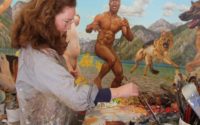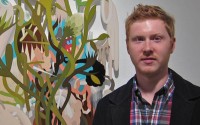Susannah Martin
Originally from New York City Martin studied at New York University under John Kacere, Sherrie Levine, Louise Lawler and Peter Campus. She was self-employed after graduation painting murals and working as a scenic artist for film and photography. She journeyed to Berlin, Germany in 1991 and currently resides in Frankfort am Main. Martin is a brilliant fine artist with an independent spirit.
“I grew up in a family of artists and have received a relatively formal education in the visual arts. My painting techniques are usually described as classic. The people in my paintings are certainly distant relatives of the salon. Rather, they indulge in the midst of our contemporary culture: We have the impression that they rather block and disturb the view of the landscape than they peacefully coexist with nature as they did then in the forest of Fountainebleau. As I try to maintain a romantic landscape, they fall into this landscape as individuals who have to cope with the ever-increasing virtual reality. They bring their dogs with them, the best friends of man and their only remaining connection to nature.”
NP: How would you describe the creative process from an idea to application of that idea to canvas? I am asking how does your mind work from inception through to the completion?
Martin: I would say that there are several phases in the process. First, I have a rough idea of what I want to communicate. This sometimes comes along with a very clear image in my mind which I then have to apply to a real life model and environment. Naturally, my idea will go through many transformations on its´ way from thought to finished painting. Once I have found a model or models who are willing to work with me, a good deal of thought and preparation goes into my photo shoot with them. I will give my models, who are usually friends, rough instructions of what I am looking for but then I let them take my idea and play with it. The interesting part is seeing what they do with it. I take thousands of photos in every photo shooting and then pour over them for years to come. Essentially I am inspiring my models to interact with their environment in very individual and personal ways and they in turn inspire me to paint about their experiences. Then begins the slow process of building a composition centered around my model or models, the landscape and sometimes animals as well. Once I have my composition worked out in the form of a collage, I begin to draw this composition on to the primed canvas. After securing my drawing with acrylic line I begin the process of oil painting. Usually I mask off the figures and work the background up to a point where I feel that It is done except for minor adjustments. Then I begin to paint the figures, jumping back to the landscape while layers of paint dry on the figures. It goes on for many layers and many weeks before I reach the level that I am satisfied with.

NP: When and how did you know your artistic talent and vision? How do you define figurative realism? Is it something that evolves within your brain and heart? Is it always evolving?
Martin: For me, contemporary figurative realism has a great deal to do with looking at the world through the camera lens. How the camera records reality has as much influence on our concept of reality now as how the human eye sees physical reality. I always allow my photographic perspective to show through, I do not try to romanticize nor do I often work directly from life. The emotional experience which has taken place for me, together with my models, out in natures is recorded in my photographic work. The process of painting is a means by which my emotional experience of my subject is transferred through my mind hand communication to the canvas. A painting is never merely about what the subject precisely looks like, it is much more about how we feel about the subject.

NP: Does art help shape our connections with the world around us? If so is our response more deterministic than say free will in that our environment determines our response and expressed through various abilities?
Martin: I absolutely believe that art helps us to connect with the world around us. It is very important to stop and consider not only what event just happened or what we observed but to acknowledge how that experience felt internally and how it has influenced us, how it has changed us. We are constantly changing and expanding our view of the world. The more time we spend examining these changes, through art, the more profound and meaningful they will be for us. In other words, art helps us to grow by giving us the time and space to carefully explore our interior and its deep connection to all living matter.

NP: As a figurative realist have you been confronted with censorship issues either officially or unofficially? What are the challenges people face that you have experienced or viewed with concerning human nudity as opposed to readily accepting images of violence? Do you see figurate realism as a cultural, political and sociological statement along with an artistic comment?
Martin: The human body as subject matter is always political. There is no way around that. The nude figure is probably the most confrontational subject that an artist can take on. Whether a viewer is open to it or rejects it, the human subject leaves no one cold. We all have intense feelings when looking at our fellow human beings. How we react to an image of the human body has to do with our most intimate personal fears and desires as well as social conditioning and expectations. I have been censored, blocked, banned and harassed many times on social media for painting the nude. It is absurd really, how could looking at another human being and painting a painting of them be seen as criminal or offensive? Everything that I do with paint is done out of love for humanity and the natural world. It is heartbreaking that some people prefer to see people being hurt and abused. Generally I think that it is because there are people who are afraid to show their love of humanity, they are afraid that it makes them look weak. Some believe that violence and aggression makes you appear strong. I disagree.

NP: What is the future of figurative realism?
Martin: Well, I have heard it said so many times that figurative painting is dead or that there is no reason to continue to paint the figure with all of the other media available. But I honestly think that is nonsense. People have been painting people and looking at paintings of people made by people for at least 40,000 years as far as we know. It has a universal human appeal which I do not see coming to an end any time soon. Nothing is more important to a human being than another human being. I don´t believe that there is such a thing as linear progress is art. There are simply thousands and thousands of artists who make art in which ever unique individual way that works for them. Some images may be called realistic, some may be called abstract, some deconstructed and many other titles in between. But I do not believe that representing the figure will ever disappear. It is a uniquely human act.

Link to the Full Article Here







